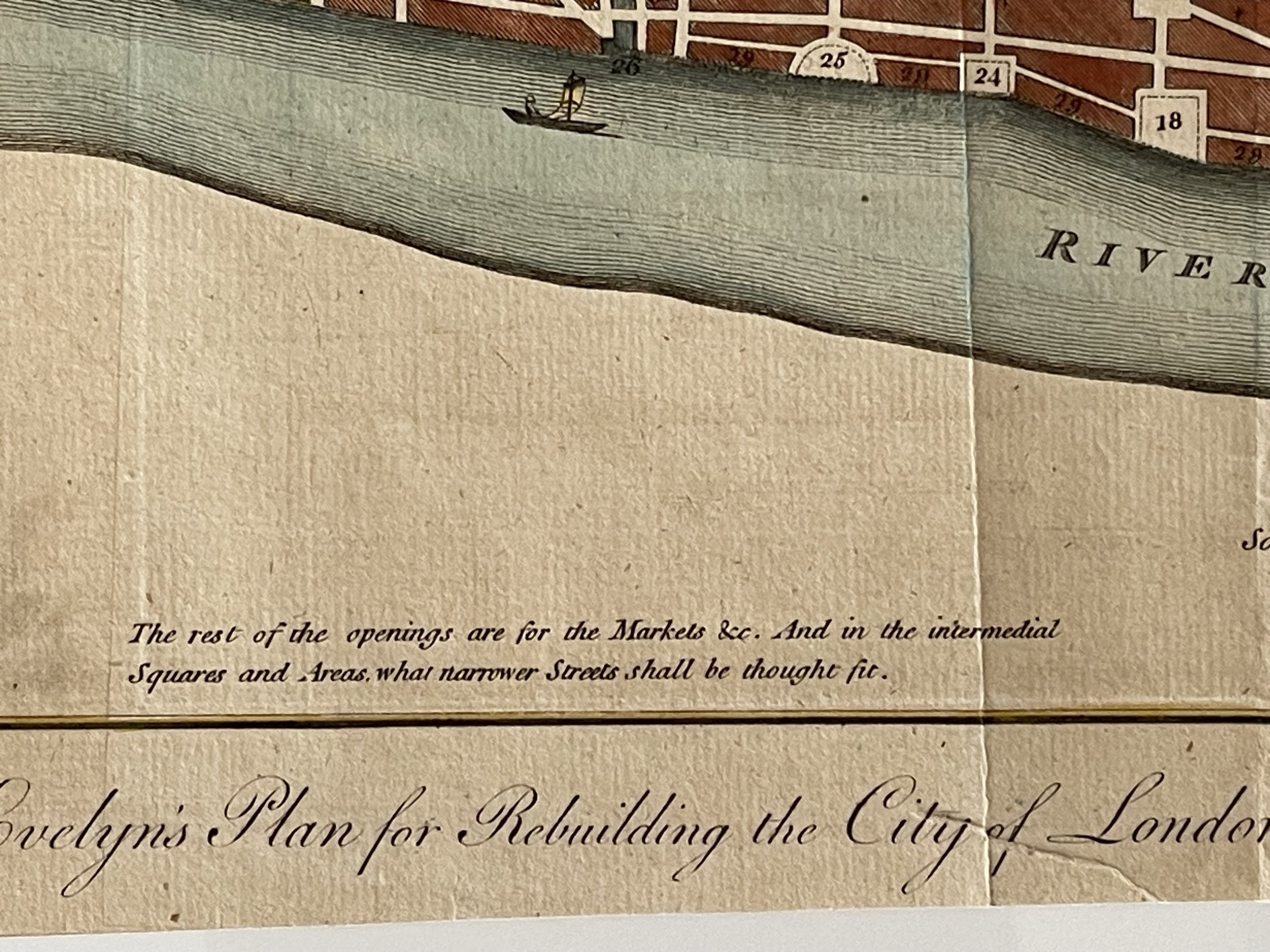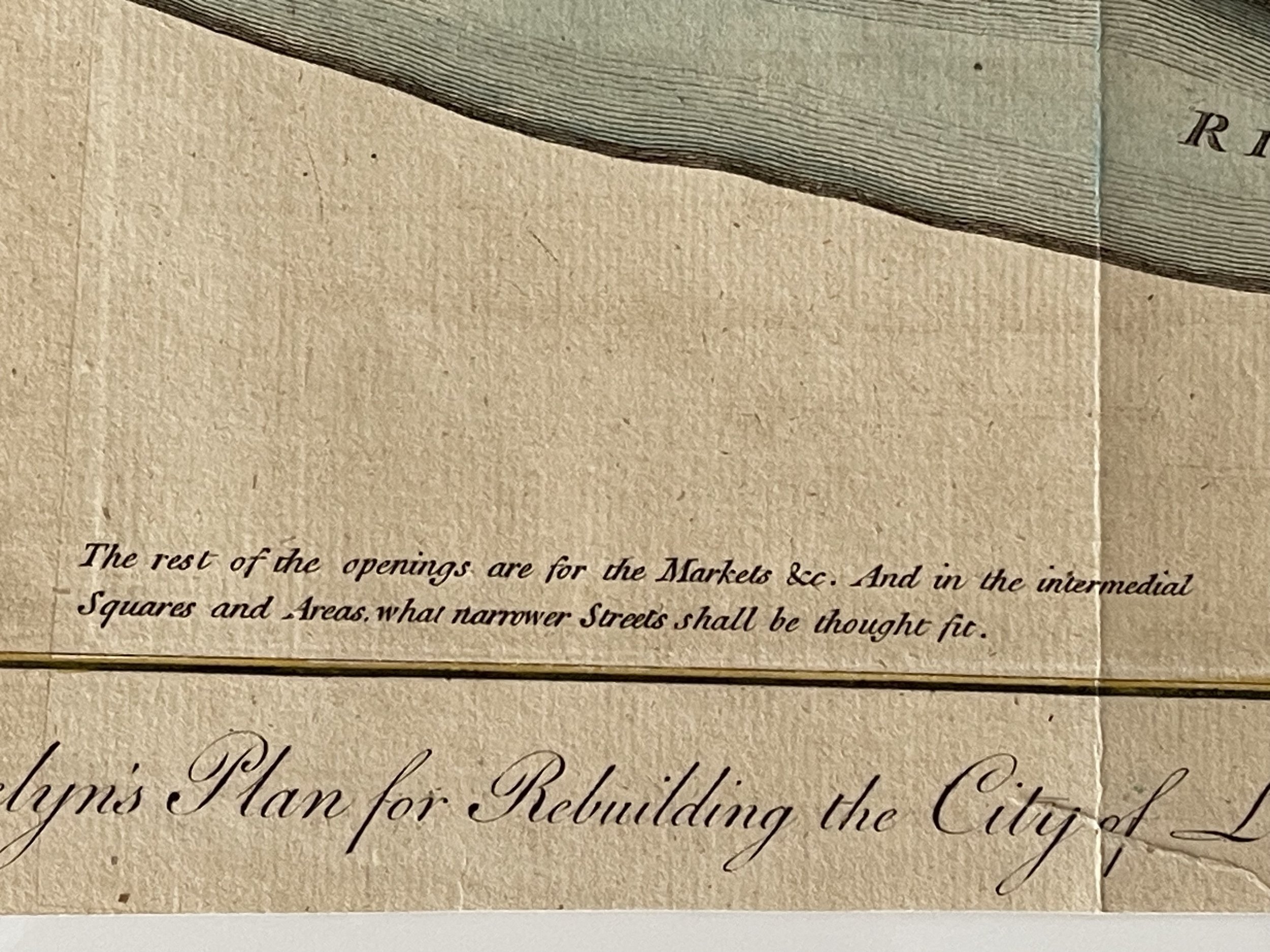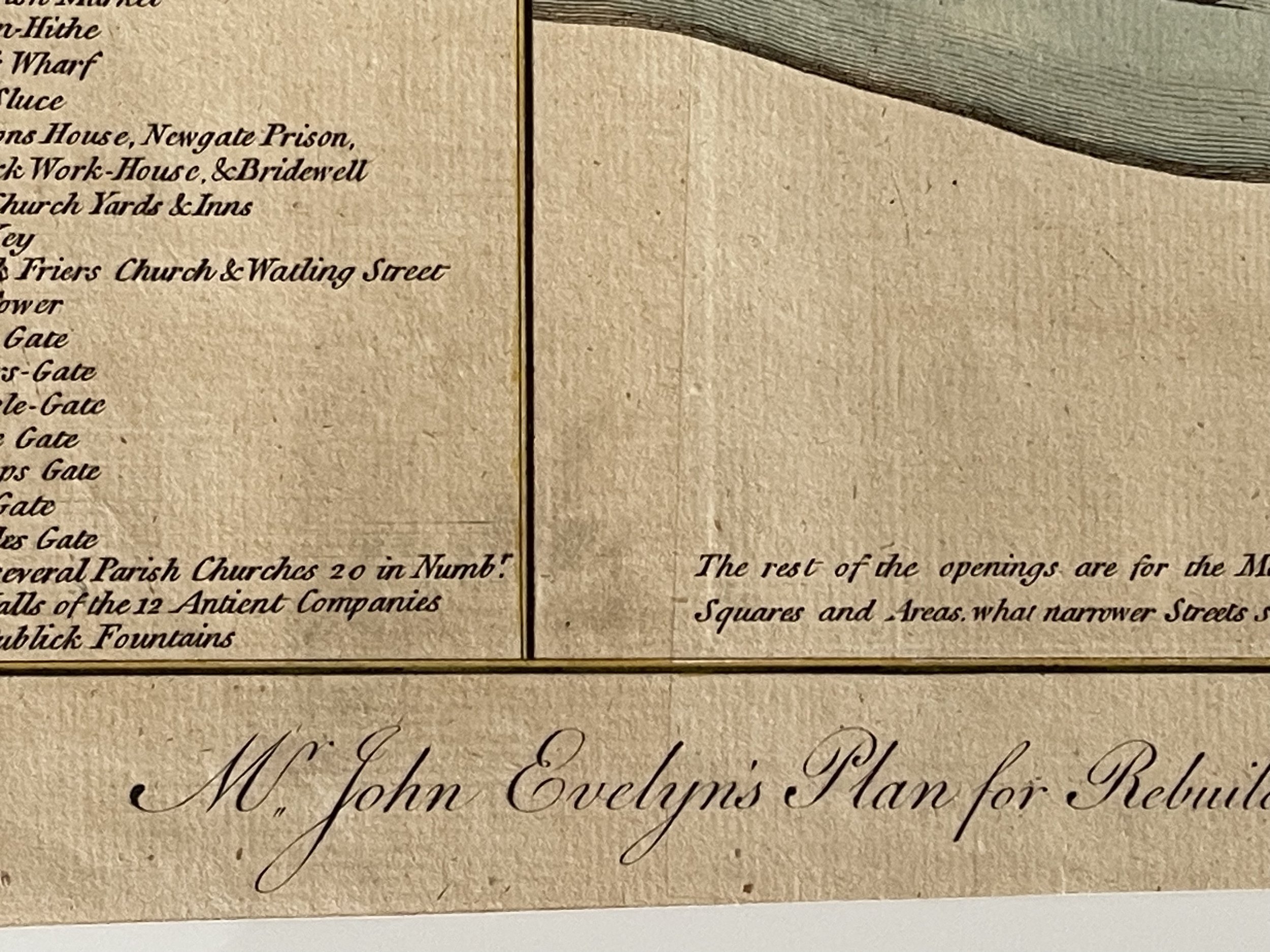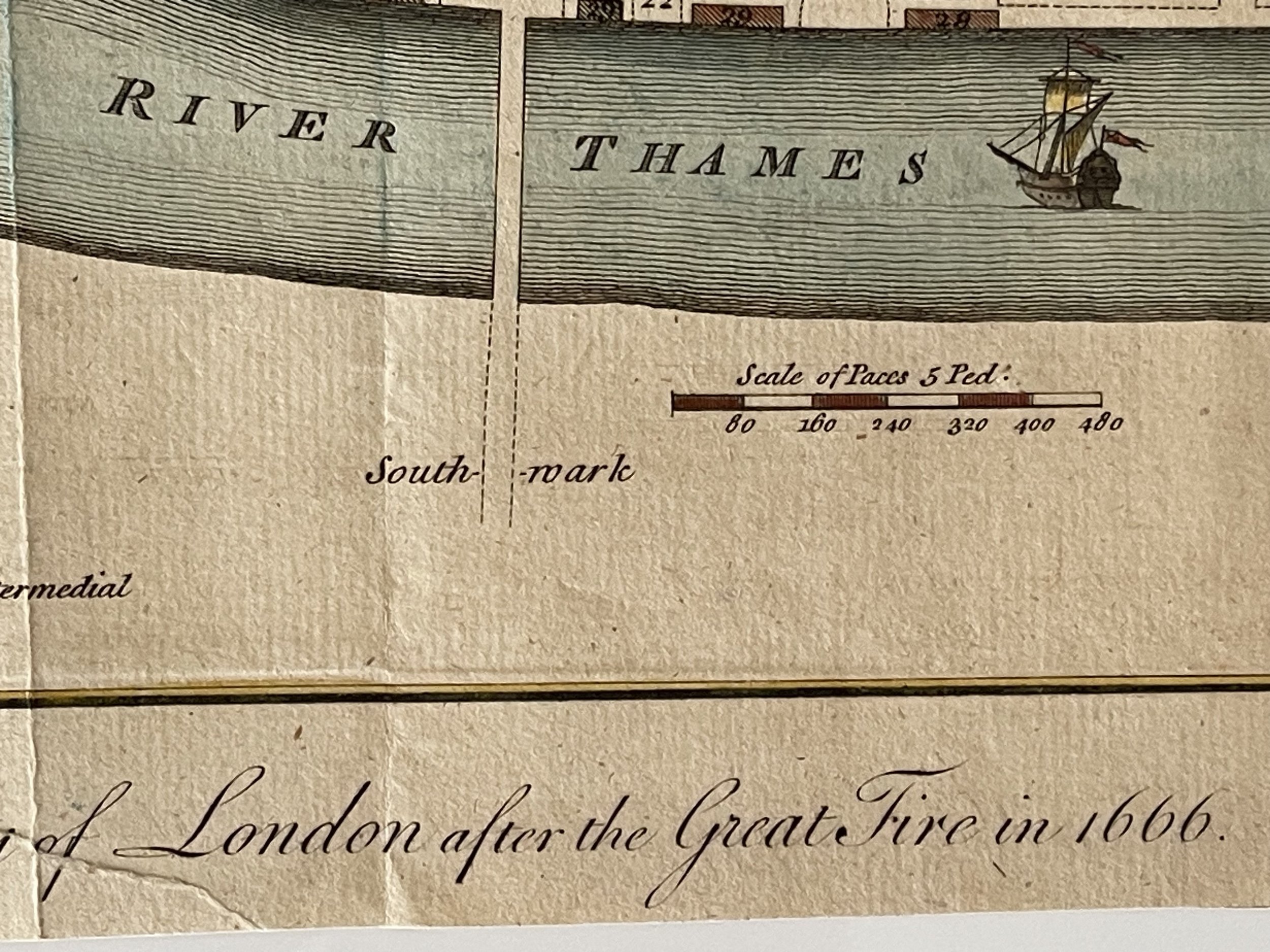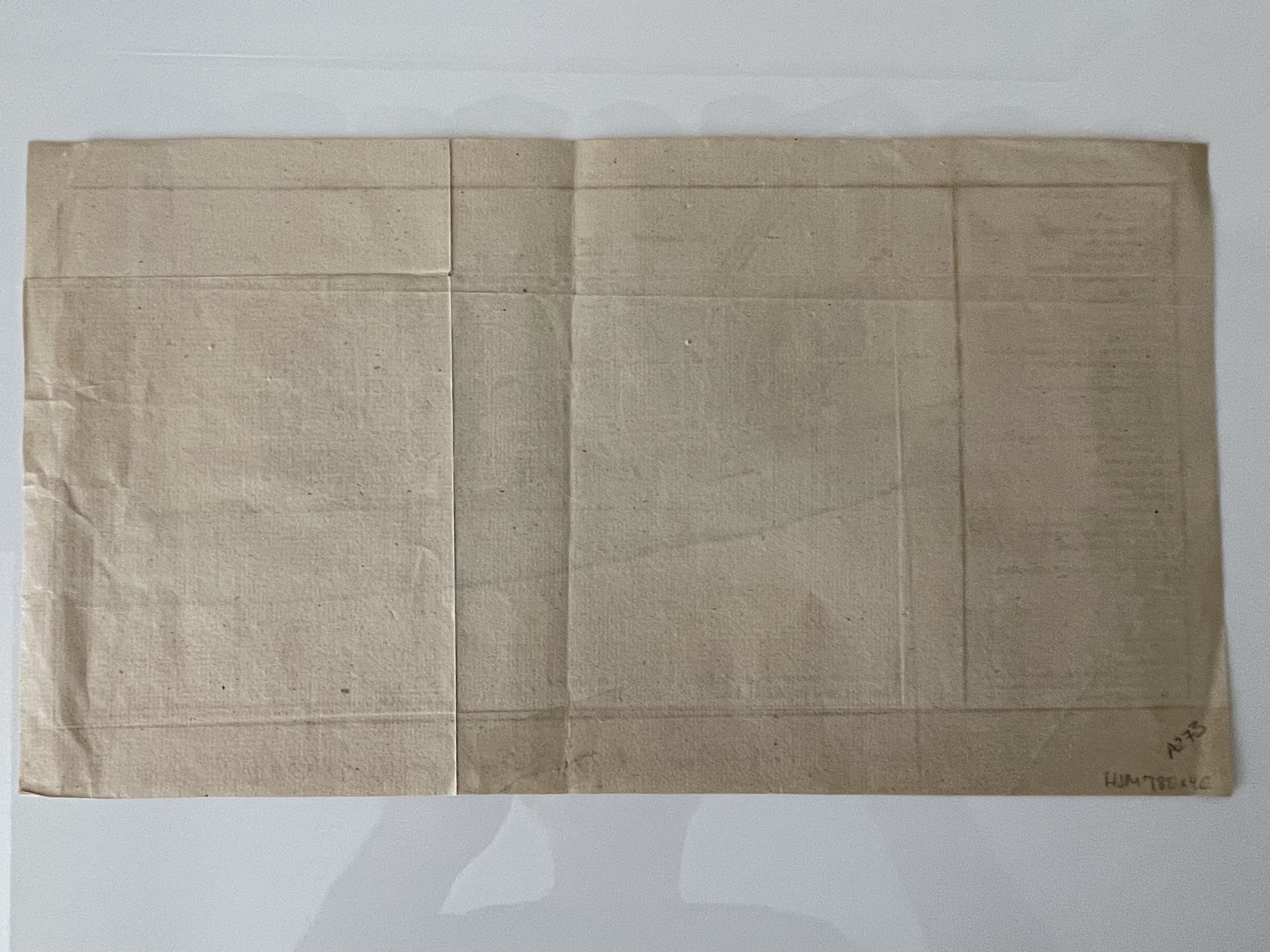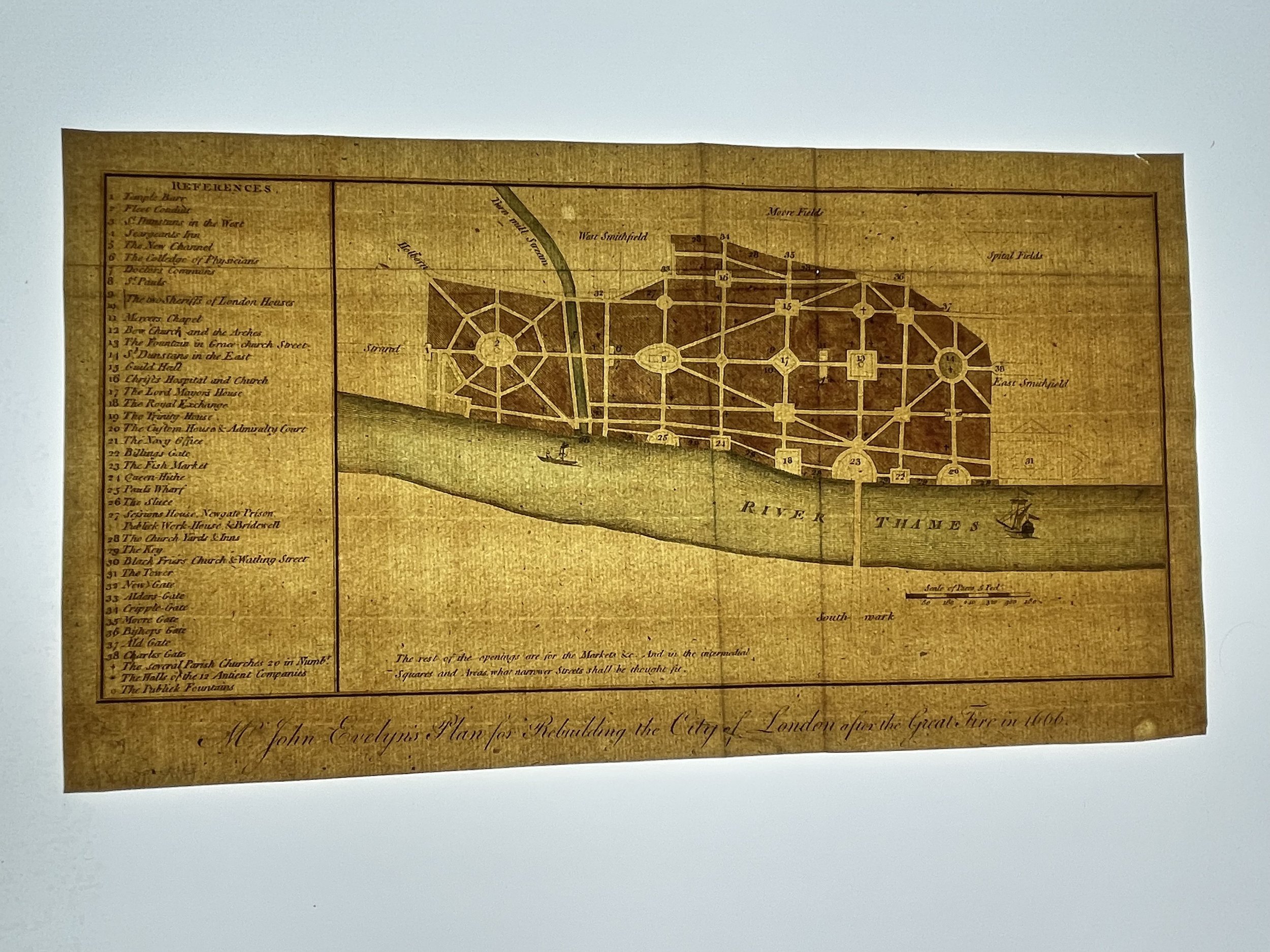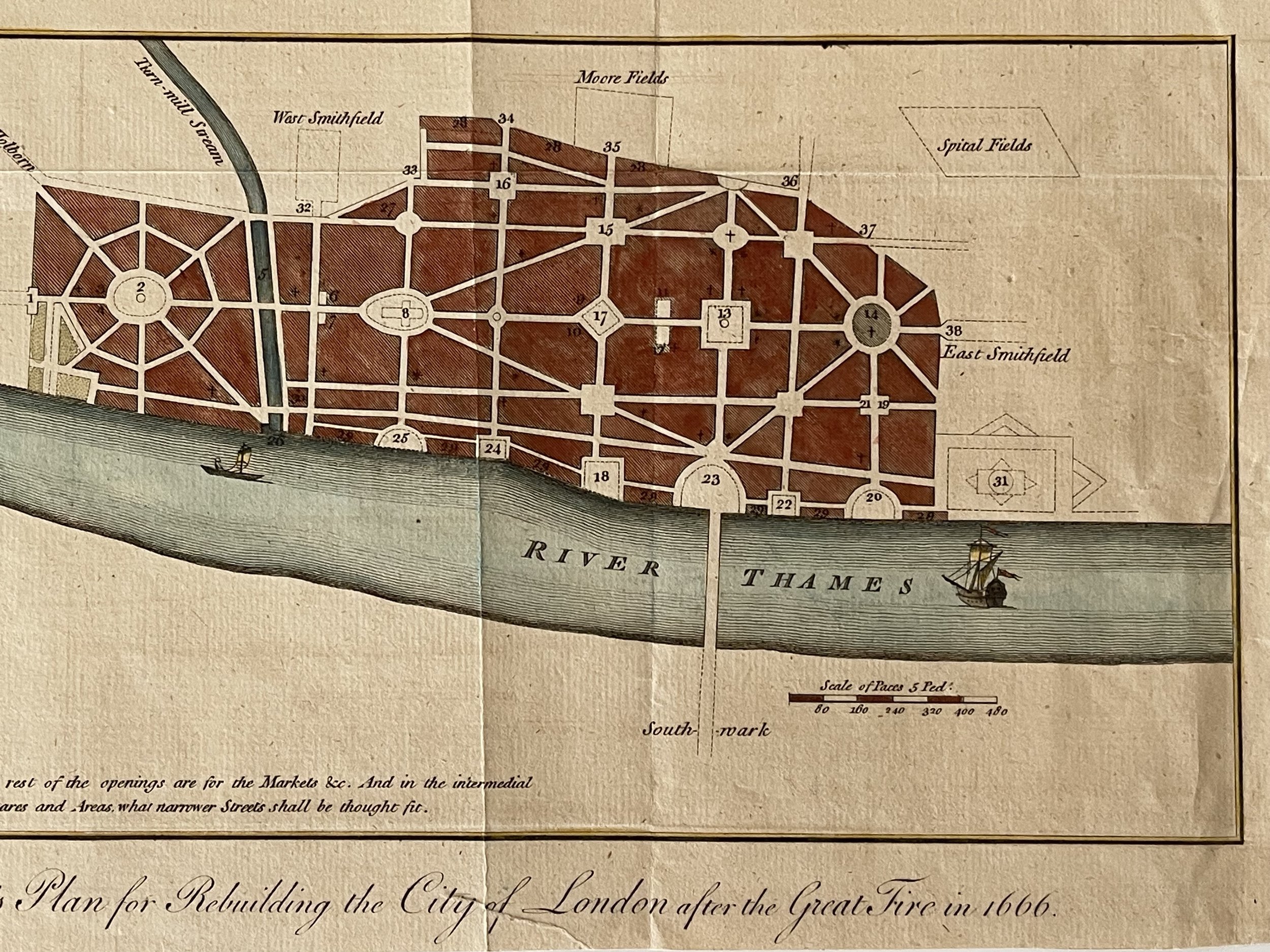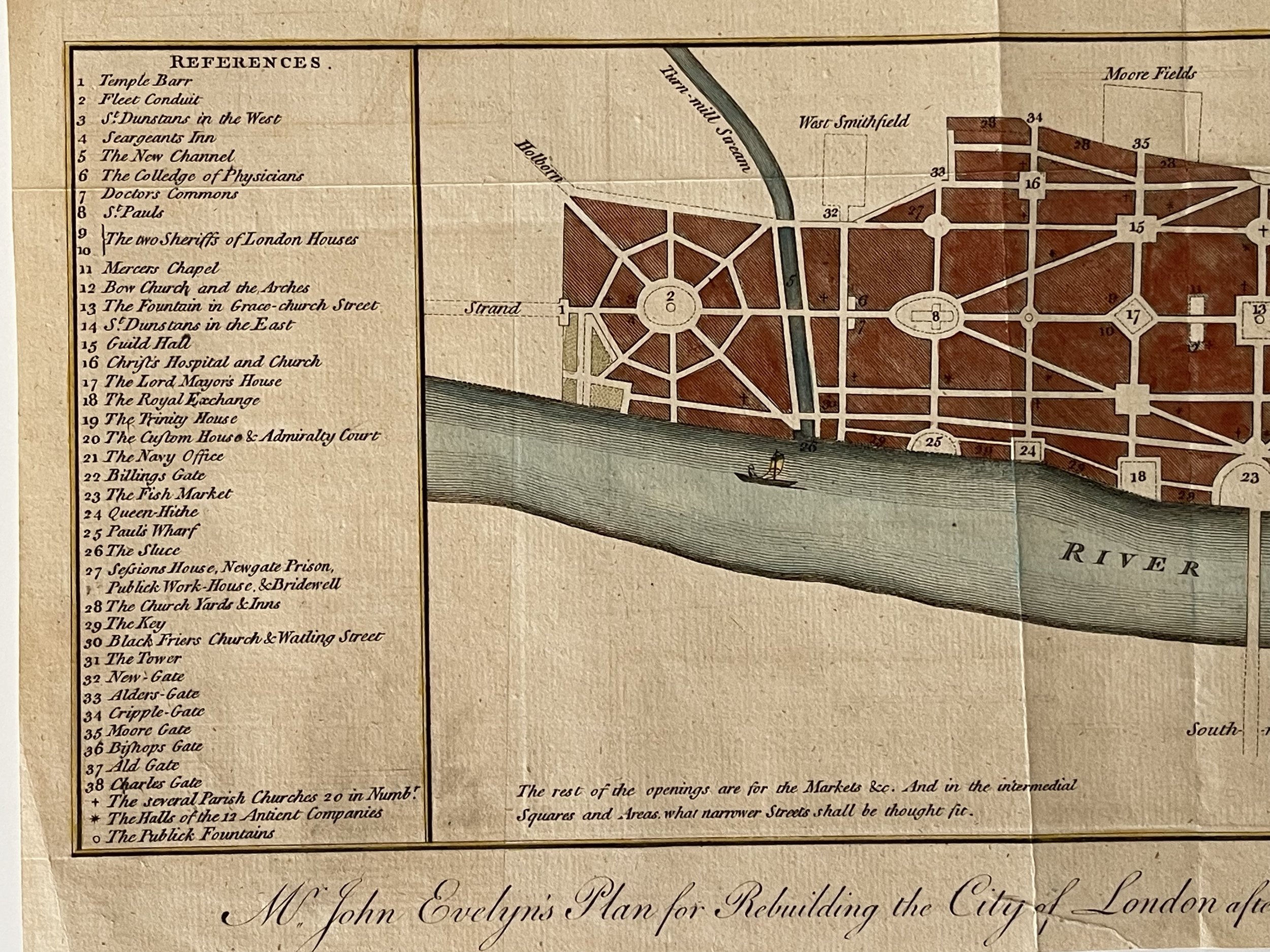Plan for rebuilding the City of London after the Great Fire in 1666 - John Evelyn - 1772
This engraving is in the National Maritime Museum Greenwich London. Very good condition.
Hand coloured antique proposed city plans by the great 17th century architect Christopher Wren and his contemporary, the diarist, gardener and draftsman John Evelyn, both of whose plans were ultimately rejected by Charles II; including landmarks on Eveylyn's map such as the Guild Hall, Newgate Prison and The Tower of London. From Noorthouck's History of London, 1772. Very good overall antique condition, text and plans together measure approx. 14 x 11.75 inches.
The engraved map of one of the unfulfilled plans for rebuilding London in the aftermath of the infamous Great Fire of 1666.
This is Sir John Evelyn's plan, which, while not as well known as Sir Christopher Wren's, was an important entry in urban planning. Its use of rectilinear avenues combining into large public squares borrowed from Continental traditions, while advancing a kind of modernity over the pre-existing Medieval layout. The map includes a key of 38 landmarks.
In 1666, the City of London burned to the ground in what has become known as the “Great Fire of London”. In 1755, just 89 years later, Lisbon was destroyed by an earthquake. Throughout this time period Lisbon and London were joined by extensive commercial ties and there are several interesting parallels between the rebuilding of these two great cities. Both processes were led by individuals deeply committed to modernization and the use of the scientific method as a part of reconstruction. At the time of the 1666 London fire, calculus was being discovered in Europe and there were early attempts to create mathematical models for the properties of materials. By 1755, the elasticity of beams was reasonably well understood and some of the first seismically engineered structures were built in Lisbon. This paper examines some of the similarities and differences between how London and Lisbon were reconstructed and the role that mathematics and engineering played in their reconstruction.
John Evelyn FRS (31 October 1620 – 27 February 1706) was an English writer, landowner, gardener, courtier and minor government official, who is now best known as a diarist. He was a founding Fellow of the Royal Society.
John Evelyn's diary, or memoir, spanned the period of his adult life from 1640, when he was a student, to 1706, the year he died. He did not always write daily. The many volumes provide insight into life and events at a time before regular magazines or newspapers were published, making diaries of greater interest to modern historians than such works might have been at later periods. Evelyn's work covers art, culture and politics, including the execution of Charles I, Oliver Cromwell's rise and eventual natural death, the last Great Plague of London, and the Great Fire of London in 1666.
John Evelyn's Diary was first published posthumously in 1818, but over the years was overshadowed by that of Samuel Pepys. Pepys wrote a different kind of diary, in the same era but covering a much shorter period, 1660–1669, and in much greater depth.
Among the many subjects Evelyn wrote about, gardening was an increasing obsession, and he left a huge manuscript on the subject that was not printed until 2001. He published several translations of French gardening books, and his Sylva, or A Discourse of Forest-Trees (1664) was highly influential in its plea to landowners to plant trees, of which he believed the country to be dangerously short. Sections from his main manuscript were added to editions of this, and published separately.
This engraving is in the National Maritime Museum Greenwich London. Very good condition.
Hand coloured antique proposed city plans by the great 17th century architect Christopher Wren and his contemporary, the diarist, gardener and draftsman John Evelyn, both of whose plans were ultimately rejected by Charles II; including landmarks on Eveylyn's map such as the Guild Hall, Newgate Prison and The Tower of London. From Noorthouck's History of London, 1772. Very good overall antique condition, text and plans together measure approx. 14 x 11.75 inches.
The engraved map of one of the unfulfilled plans for rebuilding London in the aftermath of the infamous Great Fire of 1666.
This is Sir John Evelyn's plan, which, while not as well known as Sir Christopher Wren's, was an important entry in urban planning. Its use of rectilinear avenues combining into large public squares borrowed from Continental traditions, while advancing a kind of modernity over the pre-existing Medieval layout. The map includes a key of 38 landmarks.
In 1666, the City of London burned to the ground in what has become known as the “Great Fire of London”. In 1755, just 89 years later, Lisbon was destroyed by an earthquake. Throughout this time period Lisbon and London were joined by extensive commercial ties and there are several interesting parallels between the rebuilding of these two great cities. Both processes were led by individuals deeply committed to modernization and the use of the scientific method as a part of reconstruction. At the time of the 1666 London fire, calculus was being discovered in Europe and there were early attempts to create mathematical models for the properties of materials. By 1755, the elasticity of beams was reasonably well understood and some of the first seismically engineered structures were built in Lisbon. This paper examines some of the similarities and differences between how London and Lisbon were reconstructed and the role that mathematics and engineering played in their reconstruction.
John Evelyn FRS (31 October 1620 – 27 February 1706) was an English writer, landowner, gardener, courtier and minor government official, who is now best known as a diarist. He was a founding Fellow of the Royal Society.
John Evelyn's diary, or memoir, spanned the period of his adult life from 1640, when he was a student, to 1706, the year he died. He did not always write daily. The many volumes provide insight into life and events at a time before regular magazines or newspapers were published, making diaries of greater interest to modern historians than such works might have been at later periods. Evelyn's work covers art, culture and politics, including the execution of Charles I, Oliver Cromwell's rise and eventual natural death, the last Great Plague of London, and the Great Fire of London in 1666.
John Evelyn's Diary was first published posthumously in 1818, but over the years was overshadowed by that of Samuel Pepys. Pepys wrote a different kind of diary, in the same era but covering a much shorter period, 1660–1669, and in much greater depth.
Among the many subjects Evelyn wrote about, gardening was an increasing obsession, and he left a huge manuscript on the subject that was not printed until 2001. He published several translations of French gardening books, and his Sylva, or A Discourse of Forest-Trees (1664) was highly influential in its plea to landowners to plant trees, of which he believed the country to be dangerously short. Sections from his main manuscript were added to editions of this, and published separately.
This engraving is in the National Maritime Museum Greenwich London. Very good condition.
Hand coloured antique proposed city plans by the great 17th century architect Christopher Wren and his contemporary, the diarist, gardener and draftsman John Evelyn, both of whose plans were ultimately rejected by Charles II; including landmarks on Eveylyn's map such as the Guild Hall, Newgate Prison and The Tower of London. From Noorthouck's History of London, 1772. Very good overall antique condition, text and plans together measure approx. 14 x 11.75 inches.
The engraved map of one of the unfulfilled plans for rebuilding London in the aftermath of the infamous Great Fire of 1666.
This is Sir John Evelyn's plan, which, while not as well known as Sir Christopher Wren's, was an important entry in urban planning. Its use of rectilinear avenues combining into large public squares borrowed from Continental traditions, while advancing a kind of modernity over the pre-existing Medieval layout. The map includes a key of 38 landmarks.
In 1666, the City of London burned to the ground in what has become known as the “Great Fire of London”. In 1755, just 89 years later, Lisbon was destroyed by an earthquake. Throughout this time period Lisbon and London were joined by extensive commercial ties and there are several interesting parallels between the rebuilding of these two great cities. Both processes were led by individuals deeply committed to modernization and the use of the scientific method as a part of reconstruction. At the time of the 1666 London fire, calculus was being discovered in Europe and there were early attempts to create mathematical models for the properties of materials. By 1755, the elasticity of beams was reasonably well understood and some of the first seismically engineered structures were built in Lisbon. This paper examines some of the similarities and differences between how London and Lisbon were reconstructed and the role that mathematics and engineering played in their reconstruction.
John Evelyn FRS (31 October 1620 – 27 February 1706) was an English writer, landowner, gardener, courtier and minor government official, who is now best known as a diarist. He was a founding Fellow of the Royal Society.
John Evelyn's diary, or memoir, spanned the period of his adult life from 1640, when he was a student, to 1706, the year he died. He did not always write daily. The many volumes provide insight into life and events at a time before regular magazines or newspapers were published, making diaries of greater interest to modern historians than such works might have been at later periods. Evelyn's work covers art, culture and politics, including the execution of Charles I, Oliver Cromwell's rise and eventual natural death, the last Great Plague of London, and the Great Fire of London in 1666.
John Evelyn's Diary was first published posthumously in 1818, but over the years was overshadowed by that of Samuel Pepys. Pepys wrote a different kind of diary, in the same era but covering a much shorter period, 1660–1669, and in much greater depth.
Among the many subjects Evelyn wrote about, gardening was an increasing obsession, and he left a huge manuscript on the subject that was not printed until 2001. He published several translations of French gardening books, and his Sylva, or A Discourse of Forest-Trees (1664) was highly influential in its plea to landowners to plant trees, of which he believed the country to be dangerously short. Sections from his main manuscript were added to editions of this, and published separately.
Code : A273
Cartographer : Cartographer / Engraver / Publisher: Sir John Evelyn
Date : Publication Place / Date - Circa 1772
Size : Sheet size: Image Size: 31.5 x 17 cm
Availability : Available
Type - Genuine - Antique
Grading A
Where Applicable - Folds as issued. Light box photo shows the folio leaf centre margin hinge ‘glue’, this is not visible otherwise.
Tracked postage, in casement. Please contact me for postal quotation outside of the UK.

